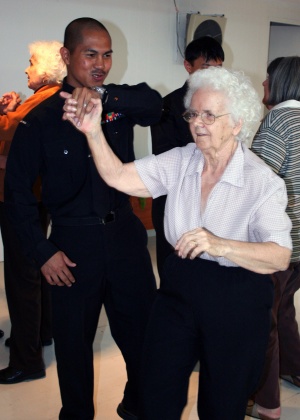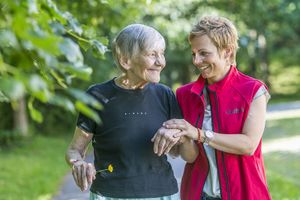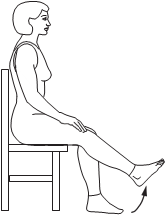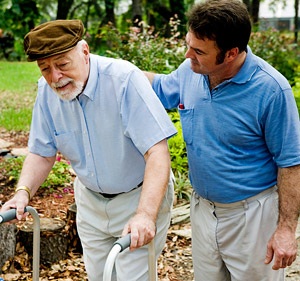Otago Exercise Programme: Difference between revisions
No edit summary |
Kim Jackson (talk | contribs) No edit summary |
||
| (14 intermediate revisions by 4 users not shown) | |||
| Line 4: | Line 4: | ||
</div> | </div> | ||
== Introduction == | |||
[[File: | [[File:Play therapy elderly dancing.jpeg|right|frameless]] | ||
The Otago Exercise Program (OEP) was developed and tested by '''the New Zealand Falls Prevention Research Group in New Zealand''' to reduce falls in older persons. | |||
The OEP consists of 17 strength and balance exercises and a walking program, performed three times a week by the older adult in the home, outpatient, or community setting. Exercises can be done individually or in a group setting. Studies demonstrate OEP participants experience a 35 – 40% reduction in falls. | |||
The program is most effective for frail older adults. It is recommended for frail older adults that a Physical Therapist (PT) assess and prescribe the initial exercises. The older adult does the exercises independently three times a week and completes a series of 4 visits with the PT, PT Assistant, or the appropriate provider over an 8-week period. | |||
Transitions to a self-management phase for 4 – 10 months. During the self-management phase, the older adult continues to independently do the exercises, and has the opportunity to check in with their program provider via monthly phone calls, and an optional face to face check in at 6 months<ref>NCOA [https://www.ncoa.org/uncategorized/evidence-based-program-otago-exercise-program/ Evidence-Based Program: Otago Exercise Program] Available from:https://www.ncoa.org/uncategorized/evidence-based-program-otago-exercise-program/ (accessed 25.2.2021)</ref>. | |||
[[File:Geriatrics physical activity.jpg|right|frameless]] | |||
== | == Aim: Falls Risk Reduction == | ||
[[Falls in elderly|Falls]] in older adults can cause significant physical<ref name=":1">World Health Organisation. [http://www.who.int/news-room/fact-sheets/detail/falls Falls]. 2018. Accessed 16 October 2018.</ref> and psychological injury<ref>Parry SW, Deary V. [https://www.bmj.com/content/328/7441/680.full?int_source=trendmd&int_medium=trendmd&int_campaign=trendmd How should we manage fear of falling in older adults living in the community?]BMJ, 2013; 346. Accessed 16 October 2018.</ref> to the individual. As a consequence, falls also incur significant health care costs<ref name=":1" /><ref>Morello RT, Barker A, Watts JJ, Haines T, Zavarsek SS, Hill KD, Brand C, Sherrington C, Wolfe R, Bohensky MA Stoelwinder JU. [https://www.mja.com.au/system/files/issues/203_09/10.5694mja15.00296.pdf The extra resource burden of in-hospital falls: a cost of falls study]. Med J Aust 2015; 203;9: 367e1-8. Accessed 16 October 2018. | |||
</ref><ref>Florence CS, Bergen G, Atherly A, Burns E, Stevens J, Drake C. [https://onlinelibrary.wiley.com/doi/epdf/10.1111/jgs.15304 Medical Costs of Fatal and Nonfatal Falls in Older Adults]. J Am Geriatr Soc, 2018; 66:693–698. Accessed 16 October 2018.</ref>. The New Zealand Accident Compensation Corporation (ACC) implemented a project with the goal of reducing falls: The Otago Exercise Programme (OEP). | |||
The | The OEP was developed by Campbell and Robertson<ref name=":3">Campbell AJ, Robertson MC. [https://www.livestronger.org.nz/assets/Uploads/acc1162-otago-exercise-manual.pdf Otago exercise programme to prevent falls in older adults]. Wellington: ACC Thinksafe. 2003 Mar;3.</ref> for the New Zealand Accident Compensation Corporation (ACC) which provides treatment and rehabilitation under a universal, no-fault accidental injury scheme. | ||
The main takeaway results from the research into Otago exercises include: | |||
* Falls among people participating in the Otago were reduced by 30% to 66% when compared to controls who were not doing Otago exercises. | |||
* After one year, injuries due to falls were reduced by 28% in participants performing Otago exercises. | |||
* The Otago exercise program was most effective at reducing falls for people over the age of 80 years, but people who were younger still found some benefit. | |||
* Seventy percent of patients performing Otago exercises continued doing the program after one year.<ref>Very well Health [https://www.verywellhealth.com/otago-exercises-for-balance-5069904 Improve Balance With Otago Exercises] Available from:https://www.verywellhealth.com/otago-exercises-for-balance-5069904 (accessed 25.2.2021)</ref> | |||
== Content of the program == | == Content of the program == | ||
[[File:Knee ext in sitting.png|right|frameless]] | |||
See this [https://www.livestronger.org.nz/assets/Uploads/acc1162-otago-exercise-manual.pdf here] for booklet of the OEP. | |||
===== '''Baseline Assessment''' ===== | ===== '''1. Baseline Assessment''' ===== | ||
The program starts with the first home visit where the physiotherapist can discuss general information and goals of the program with the patient and collect relevant clinical history information. Additionally, an intake assessment of balance and strength is performed, with the [[30 Seconds Sit To Stand Test]] and [[The 4- | * The program starts with the first home visit where the physiotherapist can discuss general information and goals of the program with the patient and collect relevant clinical history information. Additionally, an intake assessment of balance and strength is performed, with the [[30 Seconds Sit To Stand Test]] and [[The 4-Stage Balance Test]]<ref name=":3" />. Additional home visits and follow-up phone calls are performed during the program by the physiotherapist with the aim of encouraging adherence<ref>Sherrington C, Tiedemann A, Fairhall N, Close JCT, Lord SR. [http://www.publish.csiro.au/nb/pdf/NB10056 Exercise to prevent falls in older adults: an updated meta-analysis and best practice recommendations]. NSW Public Health Bulletin. 2001,22;3–4: 78-83. Accessed 13 October 2018.</ref>. | ||
===== '''2. Exercise and walking program''' ===== | |||
Based on the results of the initial assessment, an exercise and a walking program are prescribed by the therapist. The OEP comprises | |||
# 5 strengthening exercises and 12 balance exercises<ref name=":3" />. Participants are instructed to perform the exercises three times a week<ref name=":2">Gardner MM, Buchner DM, Robertson MC, Campbell AJ. [https://watermark.silverchair.com/300077.pdf?token=AQECAHi208BE49Ooan9kkhW_Ercy7Dm3ZL_9Cf3qfKAc485ysgAAAhswggIXBgkqhkiG9w0BBwagggIIMIICBAIBADCCAf0GCSqGSIb3DQEHATAeBglghkgBZQMEAS4wEQQMbvMhAOEego0zidW1AgEQgIIBzik3OxvyqLdAXXEQErFyaOmLb3MGMIIverLMxanaNYrOLhafjJC2rxv_0nzCZm892_Jpm2cHSTET_4dZ6DDx9Gi-_stkYXTIL3V-buhBNcyGgj-39YJUXHHdIacYgkgoi3Bbp7b4VFI6rY-bdz8P1FDMlIDeXbHfouwqrb_oxEVuThyWnBh-pHNIvNYfkb9zCFWj7keaAdYnI0cT6tWj8Lwmwnb_-x6MzlibFgppUvff2YzYq6dNgoEEo0_oIddihAL3ighTIL-e0zVPFRRvCJ_xRNuxQor2ijGvb8qEmVLSGcjRFKFBVSrXDDXV-gUFshyPY05OavNh2W18bOAyHGxylimXmQp582AzbZH4MlZiCYRcEvDBAJe4YzvEKjLnM4b04vudIXeZ8V7VqlaX2UYWtYQj-ey3hlCEJZXQEi5HK2FiAjBWWdnVoq9rnfGoNhf99Hx6_uO4MXbSSNUaNgftG-kxDigGOyOa9cPGVeQ87Fjy9j0PACLlTanZ86sjm6Np6ETmhJB77q7mWYvAi2zU4pWX-0r2-1eR0nuIFLdojCG7DiR3J-BMbVpEM0qyQJvSXyrj3MlRR1Qz69cbcfHg2e7AsM5aKvLalsYBng How to do it: practical implementation of an exercise-based falls prevention programme.] Age Ageing 2001; 30: 77-83. Accessed 16 October 2018.</ref>. Depending on the individual’s strength and mobility, the exercises can be progressed, by increasing the amount of repetitions or weight (ankle cuffs with weight can be used and adjusted during the program). | |||
# Participants are provided with a walking program, aiming to include a 2x week 30 minutes walking session (can be broken into smaller periods e.g. three ten-minute blocks)<ref name=":2" />. | |||
The video below shows a lady doing the program at day 14 at home. | The video below shows a lady doing the program at day 14 at home. | ||
{{#ev:youtube|https://www.youtube.com/watch?v=cC0JTSO3oww|width}}<ref>Walkers get active. Otago strength and balance program. Day 14. Available from: https://www.youtube.com/watch?v=cC0JTSO3oww (last accessed 7.5.2019 </ref> | {{#ev:youtube|https://www.youtube.com/watch?v=cC0JTSO3oww|width}}<ref>Walkers get active. Otago strength and balance program. Day 14. Available from: https://www.youtube.com/watch?v=cC0JTSO3oww (last accessed 7.5.2019 </ref> | ||
{| class="wikitable" | {| class="wikitable" | ||
|+Table 1: Exercises of the OEP<ref name=":0" />. | |+Table 1: Exercises of the OEP<ref name=":0">Campbell AJ, Robertson MC. Otago exercise programme to prevent falls in older adults. Wellington: ACC Thinksafe. 2003 Mar;3.</ref>. | ||
|Exercises | |Exercises | ||
|*start at 10 repetitions | |*start at 10 repetitions | ||
| Line 89: | Line 97: | ||
|} | |} | ||
== Indication == | == Indication == | ||
* The program is designed for | [[File:Man-walker dementia.jpg|right|frameless]] | ||
The OEP that improve balance and can help prevent falls, a common problem in many polulation eg | |||
*[[Older People - An Introduction|Older adults]] The program is designed for older adults (65+).<ref name=":3" />.Any elder person interested in preserving and improving their strength, balance and competency in Activities of Daily Living ([[Activities of Daily Living|ADLs]]) can benefit from participating in the program. | |||
*Individuals who have already experienced a fall ( ie high risk group)<ref name=":3" /> | |||
*[[Neuromuscular Disorders|Neuromuscula]]<nowiki/>r conditions ([[Multiple Sclerosis (MS)|multiple sclerosis]], [[Parkinson's|parkinsonism,]] [[stroke]]), | |||
*[[Cancer Rehabilitation and the Importance of Balance Training|Cancer Rehabilitation]] | |||
*De-conditioned Adults eg post lengthy hospital stays; long term [[Corticosteroid Medication|corticosteroid medications]]. | |||
== Concluding Words == | |||
[[Fear of Falling|Falling down can be a scary thing]], and it can cause injury and create a situation where a persons confidence with mobility is shaken. Performing Otago exercises three times a week has been shown to help improve balance and mobility and prevent falls. | |||
The Otago exercise program is a simple, effective, and fun way to improve balance and hopefully prevent falls. | |||
== References == | |||
<references /> | <references /> | ||
[[Category:Older People/Geriatrics]] | [[Category:Older People/Geriatrics]] | ||
| Line 109: | Line 119: | ||
[[Category:Older People/Geriatrics - Interventions]] | [[Category:Older People/Geriatrics - Interventions]] | ||
[[Category:Older People/Geriatrics - Physical Activity]] | [[Category:Older People/Geriatrics - Physical Activity]] | ||
[[Category:Course Pages]] | |||
Latest revision as of 12:31, 9 October 2023
Original Editor - Lauren Lopez Top Contributors - Gabriele Dara, Kim Jackson, Lucinda hampton, Lauren Lopez, Wendy Walker, Rucha Gadgil, Tony Lowe, Vidya Acharya, Tolulope Adeniji and Aminat Abolade
Introduction[edit | edit source]
The Otago Exercise Program (OEP) was developed and tested by the New Zealand Falls Prevention Research Group in New Zealand to reduce falls in older persons.
The OEP consists of 17 strength and balance exercises and a walking program, performed three times a week by the older adult in the home, outpatient, or community setting. Exercises can be done individually or in a group setting. Studies demonstrate OEP participants experience a 35 – 40% reduction in falls.
The program is most effective for frail older adults. It is recommended for frail older adults that a Physical Therapist (PT) assess and prescribe the initial exercises. The older adult does the exercises independently three times a week and completes a series of 4 visits with the PT, PT Assistant, or the appropriate provider over an 8-week period.
Transitions to a self-management phase for 4 – 10 months. During the self-management phase, the older adult continues to independently do the exercises, and has the opportunity to check in with their program provider via monthly phone calls, and an optional face to face check in at 6 months[1].
Aim: Falls Risk Reduction[edit | edit source]
Falls in older adults can cause significant physical[2] and psychological injury[3] to the individual. As a consequence, falls also incur significant health care costs[2][4][5]. The New Zealand Accident Compensation Corporation (ACC) implemented a project with the goal of reducing falls: The Otago Exercise Programme (OEP).
The OEP was developed by Campbell and Robertson[6] for the New Zealand Accident Compensation Corporation (ACC) which provides treatment and rehabilitation under a universal, no-fault accidental injury scheme.
The main takeaway results from the research into Otago exercises include:
- Falls among people participating in the Otago were reduced by 30% to 66% when compared to controls who were not doing Otago exercises.
- After one year, injuries due to falls were reduced by 28% in participants performing Otago exercises.
- The Otago exercise program was most effective at reducing falls for people over the age of 80 years, but people who were younger still found some benefit.
- Seventy percent of patients performing Otago exercises continued doing the program after one year.[7]
Content of the program[edit | edit source]
See this here for booklet of the OEP.
1. Baseline Assessment[edit | edit source]
- The program starts with the first home visit where the physiotherapist can discuss general information and goals of the program with the patient and collect relevant clinical history information. Additionally, an intake assessment of balance and strength is performed, with the 30 Seconds Sit To Stand Test and The 4-Stage Balance Test[6]. Additional home visits and follow-up phone calls are performed during the program by the physiotherapist with the aim of encouraging adherence[8].
2. Exercise and walking program[edit | edit source]
Based on the results of the initial assessment, an exercise and a walking program are prescribed by the therapist. The OEP comprises
- 5 strengthening exercises and 12 balance exercises[6]. Participants are instructed to perform the exercises three times a week[9]. Depending on the individual’s strength and mobility, the exercises can be progressed, by increasing the amount of repetitions or weight (ankle cuffs with weight can be used and adjusted during the program).
- Participants are provided with a walking program, aiming to include a 2x week 30 minutes walking session (can be broken into smaller periods e.g. three ten-minute blocks)[9].
The video below shows a lady doing the program at day 14 at home.
| Exercises | *start at 10 repetitions |
| Strength | Knee extensor |
| Knee flexor | |
| Hip adductor | |
| Ankle plantarflexors (calf raises) | |
| Ankle dorsiflexors (toe raises) | |
| Balance | Knee bends |
| Backwards walking | |
| Walking and turning around | |
| Sideways walking | |
| Tandem stance (heel toe stand) | |
| Tandem walk (heel toe walk) | |
| One leg stand | |
| Heel walking | |
| Toe walk | |
| Heel toe walking backwards | |
| Sit to stand | |
| Stair walking |
Indication[edit | edit source]
The OEP that improve balance and can help prevent falls, a common problem in many polulation eg
- Older adults The program is designed for older adults (65+).[6].Any elder person interested in preserving and improving their strength, balance and competency in Activities of Daily Living (ADLs) can benefit from participating in the program.
- Individuals who have already experienced a fall ( ie high risk group)[6]
- Neuromuscular conditions (multiple sclerosis, parkinsonism, stroke),
- Cancer Rehabilitation
- De-conditioned Adults eg post lengthy hospital stays; long term corticosteroid medications.
Concluding Words[edit | edit source]
Falling down can be a scary thing, and it can cause injury and create a situation where a persons confidence with mobility is shaken. Performing Otago exercises three times a week has been shown to help improve balance and mobility and prevent falls.
The Otago exercise program is a simple, effective, and fun way to improve balance and hopefully prevent falls.
References[edit | edit source]
- ↑ NCOA Evidence-Based Program: Otago Exercise Program Available from:https://www.ncoa.org/uncategorized/evidence-based-program-otago-exercise-program/ (accessed 25.2.2021)
- ↑ 2.0 2.1 World Health Organisation. Falls. 2018. Accessed 16 October 2018.
- ↑ Parry SW, Deary V. How should we manage fear of falling in older adults living in the community?BMJ, 2013; 346. Accessed 16 October 2018.
- ↑ Morello RT, Barker A, Watts JJ, Haines T, Zavarsek SS, Hill KD, Brand C, Sherrington C, Wolfe R, Bohensky MA Stoelwinder JU. The extra resource burden of in-hospital falls: a cost of falls study. Med J Aust 2015; 203;9: 367e1-8. Accessed 16 October 2018.
- ↑ Florence CS, Bergen G, Atherly A, Burns E, Stevens J, Drake C. Medical Costs of Fatal and Nonfatal Falls in Older Adults. J Am Geriatr Soc, 2018; 66:693–698. Accessed 16 October 2018.
- ↑ 6.0 6.1 6.2 6.3 6.4 Campbell AJ, Robertson MC. Otago exercise programme to prevent falls in older adults. Wellington: ACC Thinksafe. 2003 Mar;3.
- ↑ Very well Health Improve Balance With Otago Exercises Available from:https://www.verywellhealth.com/otago-exercises-for-balance-5069904 (accessed 25.2.2021)
- ↑ Sherrington C, Tiedemann A, Fairhall N, Close JCT, Lord SR. Exercise to prevent falls in older adults: an updated meta-analysis and best practice recommendations. NSW Public Health Bulletin. 2001,22;3–4: 78-83. Accessed 13 October 2018.
- ↑ 9.0 9.1 Gardner MM, Buchner DM, Robertson MC, Campbell AJ. How to do it: practical implementation of an exercise-based falls prevention programme. Age Ageing 2001; 30: 77-83. Accessed 16 October 2018.
- ↑ Walkers get active. Otago strength and balance program. Day 14. Available from: https://www.youtube.com/watch?v=cC0JTSO3oww (last accessed 7.5.2019
- ↑ Campbell AJ, Robertson MC. Otago exercise programme to prevent falls in older adults. Wellington: ACC Thinksafe. 2003 Mar;3.










